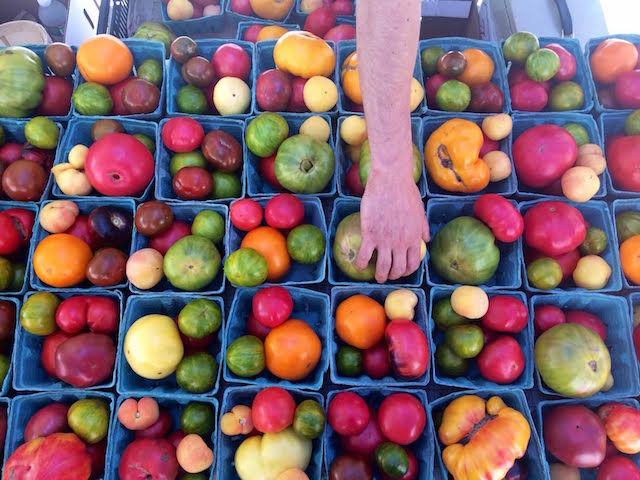
For many years now, I’ve helped establish and manage farmers markets in Philadelphia.
During those years, I’ve learned lessons and drawn inspirations from many of the fruits and vegetables sold at these markets. Every year, when they reappear for the season, I’m reminded of those lessons and so certain thoughts and ideas inside of me have their seasons too.
Below are three seasonal foods that remind me of certain truths whenever they reappear at the markets.
Granny Smith Apple
There really was a “Granny Smith.” Her name was Maria Ann Smith and she lived on a farm on the outskirts of Sydney, Australia.
According to legend, she was peeling and paring French crabapples, then tossing the cores out the kitchen window into the compost pile.
Months later, the first granny smith tree sprouted underneath her humble windowsill.
She passed away in the 1880s, a few years shy of seeing her apple reach its global popularity, one of the most recognizable foods on the entire planet.
Not bad for being borne from a compost heap.
But should we be surprised? You throw something into the compost pile so it can be born again, transformed and recycled for another use. Garbage will always be garbage, but compost?
In compost, there is potential for resurrection.
We always hear about throwing away the bad apples in our lives. I wonder though.
Instead of throwing them away, can I compost them?
More importantly, will I have the strength to return to that compost pile? I might find some sprouts, a tree where there was no tree before, a new fruit that one day might reach the entire world.
Heirloom Tomato
By the first full moon of July, the heirloom tomatoes dominates the farm-stands, quickly becoming one of the most popular, and most profitable, foods at the market.
I’m still shocked by their current success. When I was a line cook in the late 1990s, heirloom tomatoes were a hard sell.
We didn’t know what to do with them. As chefs, we loved their flavor but they kept getting sent back. According to the customers, they were the wrong color, the wrong shape, the wrong flavor.
Stop joking around, they’d say, and give us the good tomatoes.
It didn’t help that, back then, the heirloom tomato was sold under a different name. When I first met them, they were called ugli tomatoes.
That’s the corporate way of explaining that these tomatoes were supposed to be wrinkled, cracked, misshapen and even ripe when green, orange or yellow. They’re different than the norm, they were saying.
That’s why we call them ugli.
Those marketers knew the public would never remember that, in the wild, things sometimes get ugly.
The good news is that we did remember.
Now, people are fighting over the ugliest ones.
Now, they’ve even received a new, more dignified name.
They’re heirloom tomatoes, and what’s an heirloom? It’s a gift from the past, something handed down from generation to generation, a lost treasure found again at last.
Last spring, I attended a workshop for sustainable agriculture. During one of the classes, the speaker mentioned that the state’s agricultural department wanted to encourage the farmers to grow certain crops commercially, including the pawpaw.
The pawpaw? He couldn’t be serious.
Here’s the problem with the pawpaw: no shelf life.
Pawpaws have a very short season. One week, maybe. Once harvested, you have about a day to sell it or eat it. It’s better if you don’t even wait that long.
You’ll never see them in the supermarkets and can barely catch them at the farmers markets.
For that reason, many of you might not know what a pawpaw is.
It’s the largest edible tree-fruit native to North America. It’s the only tropical fruit that grows this far north and it goes by other names: the poor man’s banana, the prairie banana and, in some deep corners of the continent, it’s known as the banango.
Those names do a good job of describing its flavor: a combination of mango and banana, best when soft and over-ripe. Inside, there’s a bright and sunny orange custard of tasty goodness.
But zero shelf life.
Which makes the idea of growing them commercially so laughable.
The produce departments in the supermarkets depend on crops that are the exact opposite of the pawpaw. Cavendish bananas, Driscoll strawberries, Dole pineapples, Haas avocadoes, these are crops that can be picked unripe, hard as a rock, and easier to store and ship. They actually ripen in the strangest of places: in the darkness of a refrigerated trailer barreling down the highway or under the fluorescent lights of a supermarket 3000 miles from where it was grown.
In other words, long shelf life.
There are many lessons I can take from this kind of produce. There’s something to be said for being efficient and profitable, for appealing to the masses and available year-round.
But, honestly, I’d rather be like the pawpaw.
I want to be ready to eat the moment I’m picked. I want to be rare and special, already on my way out from the moment I arrive.
I don’t want to be kept on a shelf.
No, it’s a pawpaw’s life for me. That’s more my style.
Like the pawpaw, I want to be here today and gone tomorrow.
Relephant:
68 Reasons to Shop Locally.
3 Big Reasons to Support Your Local Farmer’s Market.
Author: Jon Glyn
Editor: Renée Picard
Image: Author’s own






Read 0 comments and reply